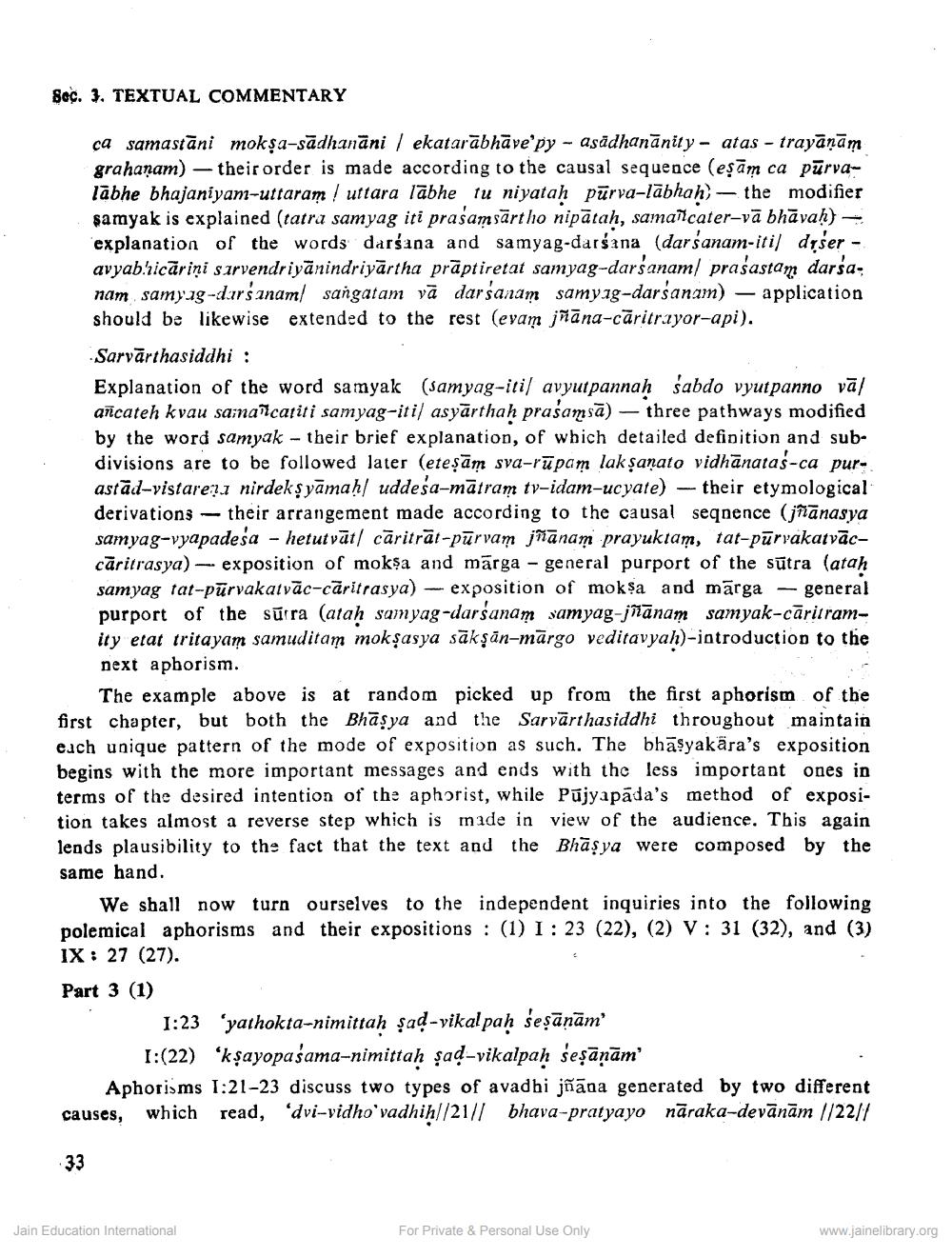________________
Sec. 3. TEXTUAL COMMENTARY
ca samastāni mok$a-sādhanāni / ekatarābhāve'py - asādhanānity - atas - trayāņām grahanam) — their order is made according to the causal sequence (eşām ca pūrvalābhe bhajaniyam-uttaram / uttara labhe fu niyatah pūrva-lābhah) - the modifier samyak is explained (tatra samyag iti prašamsārtho nipātah, samañcater-vā bhāvah) explanation of the words darśana and samyag-darśana (darsanam-itidiser - avyabricăriņi sarvendriyānindriyārtha prāptiretat samyag-darsanam/ prasastan darsa, nam samyag-darśanam sangatam vā darsanam samyag-darśanam) – application should be likewise extended to the rest (evam jñāna-cāritrayor-api). Sarvārthasiddhi : Explanation of the word samyak (samyag-itis avyutpannah sabdo vyutpanno vā/ añcateh kvau sainañcațiti samyag-itis asyārthah prasamsā) – three pathways modified by the word samyak - their brief explanation, of which detailed definition and subdivisions are to be followed later (eteșām sva-rūpam lakṣaṇato vidhānatas-ca purastād-vistare?, nirdekşyāmah/ uddesa-mātram tv-idam-ucyate) - their etymological derivations - their arrangement made according to the causal seqnence (jñānasya samyag-vyapadesa - hetutvāt/ cāritrāt pūrvam jñānam prayuktam, tat-pūrvakatvāccāritrasya) - exposition of moksa and mārga - general purport of the sūtra (atah samyag tat-pürvakatvāc-căritrasya) — exposition of moksa and mārga — general purport of the sūrra (atah samyag-darsanam samyag-jñānam samyak-cāritramity etat tritayam samuditam mokşasya sākşān-mārgo veditavyah)-introduction to the next aphorism.
The example above is at random picked up from the first aphorism of the first chapter, ut both the Bhāşya and the Sarvārthasiddhi throughout maintain each unique pattern of the mode of exposition as such. The bhāsyakära's exposition begins with the more important messages and ends with the less important ones in terms of the desired intention of the aphorist, while Pūjyapāda's method of exposition takes almost a reverse step which is made in view of the audience. This again lends plausibility to the fact that the text and the Bhāşya were composed by the same hand.
We shall now turn ourselves to the independent inquiries into the following polemical aphorisms and their expositions : (1) 1:23 (22), (2) V: 31 (32), and (3) IX : 27 (27). Part 3 (1)
1:23 yathokta-nimittah şad-vikal paḥ seșāņām'
1:(22) ‘kşayopasama-nimittaḥ şad-vikalpaḥ seșāņām' Aphorisms 1:21-23 discuss two types of avadbi jñāna generated by two different causes, which read, 'dvi-vidho'vadhih/21// bhava-pratyayo nāraka-devānām //2211
33
Jain Education International
For Private & Personal Use Only
www.jainelibrary.org




